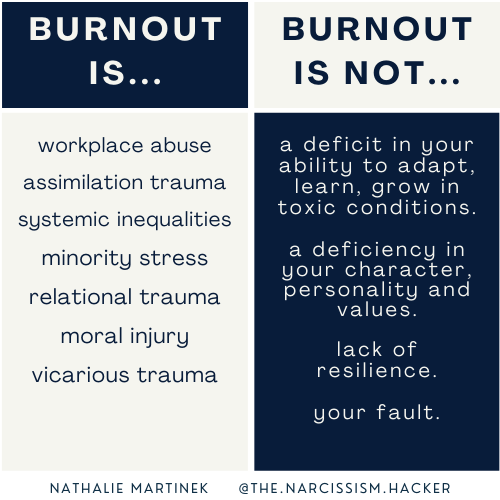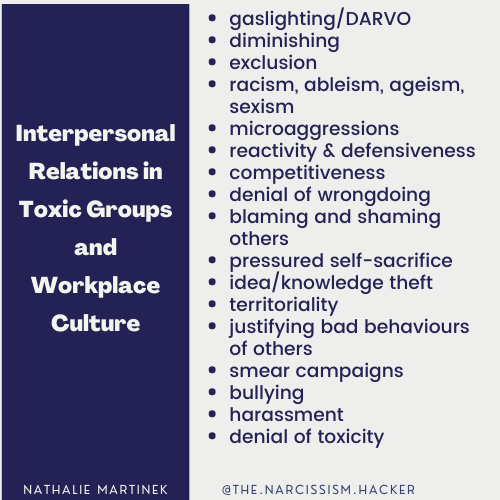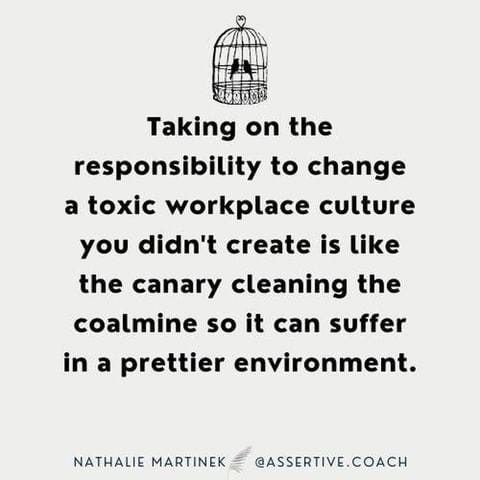Thank you for spreading the word about this newsletter and for your continuing support of my work. Your paid subscription acknowledges the value and impact of my work. This is a premium article with a free preview. If the content resonates with you, please consider a monthly or annual paid subscription.
If a paid subscription isn’t an option for you right now, please consider sharing my content with your networks to support their narcissism hacking efforts.
Any relationship has the potential to go sour. Whether it’s an intimate, friendship, family member relationship, professional or workplace relationship, relationships that held promise at the start can become annoying, then draining, then detrimental to your wellbeing.
This experience is what’s often referred to as a toxic relationship.
This is also the experience people have when they work in a toxic workplace. I’m not referring to a physical environment that is toxic. I’m referring to a relationship or workplace culture: the explicit and implicit rules, values, expectation, norms and behaviours that govern how individuals relate with one another in order to attain success. It’s the culture, often created by those at the top of a workplace hierarchy or co-created by two people who form a relationship, that can become toxic.
The foundation of a toxic relationship and workplace is DISTRUST. We generally don’t form new relationships with people we initially distrust. We form a relationship as a result of building rapport with the other and assessment of each other’s trustworthiness. The same principles that you might use to build any type of relationship with another apply in personal or professional contexts. Eventually you begin to trust the other person and that affects how much you give, share and open to the other.
When you experience something that disrupts your perception of the other person, and you’re unable to restore your original view of them that led you to trust them, this shift has an impact on their trustworthiness, whether you’re aware of it or not. If you have similar experiences enough times that cause you to doubt the intentions of the other person, you know they’ve lost your trust.
Trust is fundamental for building and sustaining healthy relationships where both parties feel safe to express themselves honestly and respectfully, and take risks without fear of retribution or retaliation. Mutual trust is relationships is accompanied by feeling secure, stable, at ease, respected and valued. You come away from encounters feeling secure in the relationship and uplifted even though you might have disagreed or experienced tension. When trust is experienced as a group, you have the foundations of psychological safety.
Relationships where those feelings are absent are likely to feel toxic over time. Toxic friendships, social groups (including family), professional relationships and workplace cultures feature specific attitudes, behaviours and practices.
Checklist: Toxic group/workplace practices
Distrust (ie. micromanaging)
Favouritism
Urgency and perfectionism
Low morale & venting
racist, misogynist and other discriminatory beliefs and language
Fear of disclosing psychological status to avoid being shamed
Lack of appropriate recognition of contributions/effort
Absent accountability and finger pointing
Resistance to new ideas/suggestions for improvement
Gossip, targeting others with criticism, rumours and two-faced behaviour
Rules/policies that are enforced unequally & inconsistently
Narcissistic Leadership (ie. a dominant friend/colleague)
Unclear expectations, lack of transparency & shifting goal posts
Compliance, sacrifice and service to the other person/work
Demand for excellence while being used/poor staffing for high workload
Your needs matter less/deliverables over wellbeing
People in toxic personal and professional group contexts exhibit survival mode behaviours. Survival mode behaviours occur when people in any context are in a chronic emotionally dysregulated state. You are emotionally dysregulated when you feel unsafe or perceive a threat to your comfort and security. When you zoom into what might be happening between individuals in these group contexts, these are the behaviours that you’ll see:
You might still need convincing as to whether you’re in a toxic relationship or group.
An additional option is to reflect on how you felt about yourself before you entered into the relationship/group/workplace to how you feel immediately after exposure to the person/group/context. A healthy relational or workplace environment will enable you to feel self-confident, secure, free to take risks and emotionally regulated.
Free subscribers can see a preview of this premium article. The rest of the article describes the psychological impacts of toxic workplaces & relationships, what NOT to do and what to do when you discover you’re in one. Upgrade now to access the full article.
The emotional and psychological impact on you when you’re in a toxic relationship or a toxic workplace
You’ll feel:
constant shame
anxiety
inferiority and inadequacy
imposter syndrome
catastrophizing
ruminating
self-doubt
hypervigilance
self-criticism
needing validation
pressured productivity
feeling drained
low energy
This is unsustainable regardless of how confident you once felt. You might also experience cognitive dissonance that will tempt you to seek redeeming aspects of the relationship/workplace while denying the negative impact it’s having on your emotional and psychological wellbeing. This attempt to create a more acceptable narrative that reflects an idealistic view of your situation is gaslighting.
Peers and health professional might also suggest you’re experiencing symptoms of burnout (more gaslighting) when the reality is the relational environment is toxic and potentially traumatizing.

Furthermore…

What to do when you discover you’re in a toxic relationship or workplace
DON’T:
Call it out (unless you’re comfortable being seen as a threat to relationship status quo)
Attempt to get peers, mutual friends or colleagues onside to see what you see. It’s unlikely they will unless they’ve come to you and shared experiences that sound similar to your own (see final section in link).
Try to hold someone or the institution accountable.
Engage in saviourism to fix or rescue the relationship/person/workplace/institution in order to heal self or prevent harm of others.
Gaslight yourself to ignore existing trauma or avoid acknowledging the impact the person/group/workplace is having on you
Blame representatives of the institution or protect the institution or its practices
DO:
Sit with and acknowledge all your emotions and resist taking action until you have a clear understanding of your situation - risks, threats, supports and needs.
Debrief with a trusted friend or professional not affiliated with that relationship/workplace to explore your situation and gain new insight that can inform your next move.
Strategize how you will emotionally disengage from the relationship, group or workplace politics and develop a plan to execute your next step.
Gather supportive people and/or services to help you implement a plan to buffer from the toxicity and transition out of the toxic relationship/group/workplace.
In summary: the aim is to be in relational contexts that are emotionally regulating and support self-confidence, security and stability. This doesn’t mean they are absent from discomforts, challenges or even conflict. These destabilising experiences are necessary for growth, innovation and learning, as long as there is enough safety and trust among members of any relationship or group to take risks.
Anyone who compromises your capacity to achieve these aims do not deserve your trust or even access to you. Your ability to navigate toxicity in these relational settings while minimally internalizing toxicity requires emotional regulation, assertiveness and negotiation skills and a few supportive people who can hold you while you implement these skills strategically.
Questions about how to do this without harming your career aspirations, reputation or social connections? Ask below!
Thank you for reading, sharing, subscribing and supporting my work,
Nathalie Martinek, PhD
The Narcissism Hacker
Hack narcissism and support my work
I believe that a common threat to our individual and collective thriving is an addiction to power and control. This addiction fuels and is fuelled by greed - the desire to accumulate and control resources in social, information (and attention), economic, ecological, geographical and political systems.
While activists focus on fighting macro issues, I believe that activism also needs to focus on the micro issues - the narcissistic traits that pollute relationships between you and I, and between each other, without contributing to existing injustice. It’s not as exciting as fighting the Big Baddies yet hacking, resisting, overriding and deprogramming our tendencies to control others that also manifest as our macro issues is my full-time job.
I’m dedicated to helping people understand all the ways narcissistic traits infiltrate and taint our interpersonal, professional, organisational and political relationships, and provide strategies for narcissism hackers to fight back and find peace.
Here’s how you can help.
Order my book: The Little Book of Assertiveness: Speak up with confidence
Support my work:
through a Substack subscription
by sharing my work with your loved ones and networks
by citing my work in your presentations and posts
by inviting me to speak, deliver training or consult for your organisation





Really interesting article Nathalie. The advice around what to do not and not to do goes against all of my instincts to fight to make a workplace better. It does leave me feeling a bit hopeless. Is it possible to create a non-toxic ecosystem in a team within a broader toxic workplace?